One weekday there was a slight break from the blazing heat of July 2015 (as it turned out August and September were even more blazing) and I decided to walk some of the northern reaches of Astoria through to northern Jackson Heights, where I had not been for a few years. I didn’t to to the far north of Astoria (which should really be called Steinwayville, as the piano-making German family’s stamp there is still quite evident, with factory, a mansion, a church, and several blocks oriinally home to factory workers and supervisors). I stayed south of the Grand Central Parkway and plumbed regions I hadn’t invaded in depth.
GOOGLE MAP: ASTORIA-JACKSON HEIGHTS

My trip began on the platform at Queensboro Plaza, the only station in the city servicing both BMT and IRT trains from the same platform. The reason for this arrangement is because both the Astoria and Flushing Lines were serviced by both the IRT and BMT trains from their beginnings in 1917 through 1949, when the lines were divided with the Astoria Line awarded to the BMT, and the Flushing to the IRT. BMT trackways are a little wider, as a rule, than the IRT’s ane even today, there’s precious little room…maybe an inch or two… between the Astoria Line station platforms and the doors of the cars!
Above is a work train pulled by an engine car, OL936. I’m going to depend on FNY subway buffs for this one because after hunting and pecking for a half hour at the NYCSubway work trains page, I couldn’t find this listed. It does appear to be a newer engine.

It wasn’t too long before a #7 Flushing Line train arrived. I noticed it was one of the now-vanishing breed of R-62A cars employed on the line; these are being rapidly phased out and replaced by R-188 cars, many of which still have a “new car smell.” The R-62As and their brothers, the R-62 cars, first saw NYC subway tracks in 1983. The R-188s were introduced in 2012.
The R-62As on the Flushing Line were first introduced in 2003 and rapidly took over for R-33 and R-36 cars, introduced on the line in 1964, taking passengers to the 1964-1965 World’s Fair; they were painted in light blue and white in those days, and some carried the names of sponsoring states. After several years spent being covered in graffiti, a dark red — maroon color was settled on and the cars became known as “redbirds.” A few Redbird cars can still be seen in the Corona Yards near Citifield.
I was traveling to the Astoria Broadway station and waited a few more minutes for the N. I was indeed fortunate to see a set of R-68 cars pull in; the N usually employs newer R-143 cars, but for the summer, some trainsets were being used on different lines.
The R-68s, introduced in 1986, featured the same color scheme and seating layout as the older R-46 cars first introduced in the mid-70s. The chief difference (for me at least) is that while the R-46 has light brown/buff walls with faint alternating seals of NYC and NY State on it, while the R-68s have shiny silver walls with vertical striping.
I mourn the eventual phaseouts of the R-46 and R-68/68A cars, since the seating scheme allows you to sit, turn your head and watch the borough go by, at least on the elevated lines, and closely observe the stations in the underground lines. I also prefer the roll signs in front of the trains that display the line colors.
I do not know why the MTA has used the bench system for the new R-143 and R-188 cars, which gives you a great view of the guy clipping his nails or eating takeout chicken opposite you. But I’m just a crank.
Queensboro Plaza uses reproductions of classic lampposts used on many IRT and BMT lines when the stations were first constructed in the 1910s and 1920s (yes they are rusting already).

The northbound stair to the Broadway station on the Astoria Line is brand new, with new steps and railings, new lighting, paint job and signage. I hope the MTA also plans on replacing the opposite stairway.

For the past two years a welcome addition in Long Island City has been the Astoria Bookshop at 31-29 31st Street, just north of the Broadway N/Q train station, especially refreshing in an age when independent bookstores as well as large chains are becoming harder to find. In fact, as of August 2015 it was Queens’ lone indie bookstore. It features books by Queens authors, children’s events and sponsors the Newtown Literary Journal, a nonprofit helping authors who are just starting out. I gave a presentation here when my latest, Forgotten Queens, had just come out, in February 2014.
Who says home video is dead? The industry is trying to kill DVDs — it has already killed VHS and the last Betamax machine rolled off the factory line this week (they still sold them in Japan) but it’s still going strong here in Astoria at 31st Street and 31st Avenue.
You never know what you will find under elevated trains. These cylindrical Dwarf posts used in some spots along 31st have a completely different base design; I’ve recognized it from posts I’ve seen in New Jersey cities, but it’s not found in New York except for short poles used under els.
Though the Greek Orthodox congregation of St. Demetrios has been in existence since 1927, its neo-Byzantine cathedral at 30th Drive and 31st Street was completed in 1975. The titular saint was a soldier and Christian martyr in the 4th century in the Greek province of Thessalonica, which was then occupied by the Roman Empire.

Where every street is named 30: I was fascinated by this frame dwelling with a wraparound porch and gently-angled bay window at 30th Drive and 30th Street. Take a look at the dormer with one central arch window flanked by two tiny square ones. The porch is so shady air conditioning is likely not necessary. To its left is the usual expedient, cheap “Queens crap.”

Across 30th Street is a pair of classic walkup apartment buildings from the 1900-1920 period. Nothing fancy here, just casual elegance.

A bit further south on 30th Street, there’s this object. Astoria is known for eclecticism in housing stock, and this looks like the owners have built a fine mausoleum for themselves years before they need one.

I wonder what this slight 2-story plus attic frame building on 30th Street looked like before the siding was slapped up.

A handsome group of Brooklyn-style apartment buildings on 30th Street north of 30th Drive.

I set out north on 30th Street and then east on 30th Avenue, here looking west at 33rd Street, where Newtown Avenue branches in a northwest direction. Newtown Avenue, 30th Avenue and Newtown Road, which picks up just east of Steinway Street, are all part of the same colonial-era pathway that was a main route in Astoria before the overall street grid took shape beginning in the late 19th Century. It is an Indian trail that became the main road to early Astoria settler William Hallett’s farm in the mid-17th Century, and to the treacherous Hell Gate, the east River crossing to Manhattan. Its eastern stretch ended in the heart of Newtown, now Elmhurst, was called Hurlgate, or Hellgate, Ferry Road; later named for the town through which it passed, becoming Woodside Avenue south of Northern Boulevard.
Such exceptions to the overall grid usually point to older, more historic pathways, and usually draw the attention of your humbled webmaster.
Note that the Retro Corvington awkwardly carries a modern J-shaped fire alarm indicator shaft. It always frustrated me that the Department of Transportation never had a desire to make a mold of the fancier brackets that these posts originally carried.

The increasing gentrification or hipsterfication or highrentification of various neighborhoods has produced a trend that I actually do like: interesting store signage. This one at 37th Street combines raised letters in different fonts, some recognizable, some not. It’s apparently a Louisiana-style restaurant a few steps up from Popeye’s.
I’ve mentioned often that I enjoy Astoria and would consider moving there but for its skyrocketing residential costs. There are no fewer that three main shopping/dining stretches: 30th Avenue, Broadway and Steinway Street, and 30th Avenue even has a hobby shop, or rather a hobby shop that has to share its space with religious hexerei.

Just past 37th Street at 37-06 30th Avenue. My guess was that this place is named the Greyhound, but I had to look it up on the world wide web to find out that it is actually called The New York Dog House. Fancied-up hot dogs are the main menu items.
I hate to say it but I don’t like the trend of not spelling the name of your establishment out on the sign. Some places have no sign at all! It communicates that this place is for those in the know and that newbies are not welcomed.

The former Astoria Theatre, 30th Avenue and Steinway Street, opened in November 1920 by the Loews organization as a 2750-seat, one-screen, one-auditorium venue that, like most theaters of its time, was also home to musical and vaudeville acts. It survived as a theater until fairly recently, closing on December 26, 2001 as the United Artists Astoria Sixplex. Home to a Duane Reed drugstore and a gym chain now, it’s still quite recognizable as a former theater, with its grand arched entrance and marquee still intact.

Loews also opened the Triboro just one block away at Steinway and 28th Avenue. It was a 3,290-seat movie palace designed by Thomas Lamb, completed in 1931. This image is from 1943 when the theater featured Humphrey Bogart in Sahara and Edward G. Robinson in Destroyer. The Steinway Merchants were also running a promotion crowning Miss Steinway. The theater was demolished in 1974 and was replaced by humdrum housing. Photo from Forgotten Queens

This is the northern end of today’s Newtown Road, which runs from 30th Avenue east of Steinway Street southeast across the grid to Northern Boulevard and Woodside Avenue. As mentioned above, Newtown Avenue, 30th Avenue, Newtown Road and Woodside Avenue were once the same aboriginal road modified in colonial days as a road from the East River into the heart of Newtown at today’s Broadway and Queens Boulevard. The road’s odd path derives, in part, from the only dry ground amid numerous marshy areas and swamps that have largely now been subsumed under asphalt pavement.

I haven’t been in Queens Comfort yet but one of these days, I will probably visit, budget allowing. So-called comfort food is my kind of thing –the lunch menu features pulled pork, various burgers, waffles and chicken, tater tots and gravy, a Southern-type menu. Reviewed fairly decently. The only objection I have is that they apparently don’t carry Coke or Pepsi.

Grand Court, NE corner of 30th Avenue and Steinway Street. Queens’ old street names are often preserved in apartment building names, and here’s one such example. Grand Court is rendered over the door with a great deal of panache, and was built when 30th Avenue in Astoria was called Grand Avenue. (There’s also a substantial Grand Avenue in Maspeth and Elmhurst that is an extension of Williamsburg, Brooklyn’s Grand Street; in fact, Flushing Avenue, which runs through parts of Brooklyn and Queens, intersects a Grand Avenue in Clinton Hill and ends at another one in Maspeth!)
East of 41st Street, 30th Avenue enters the Mathews Zone: several blocks of apartment buildings constructed with yellow bricks from the kilns of Balthazar Kreischer in the far south end of Staten Island and developed by Gustave X. Mathews beginning in 1915.
The Mathews Model Flats were built by speculative developer Gustave X. Mathews and designed by Louis Allmendinger in the early part of the 20th Century. Considered to be some of the most innovative housing in the city, these “new law” tenements were designed with more space and better sanitation than their overcrowded 19th Century counterparts. By making use of generous lot sizes, introducing wide air shafts to provide improved air circulation and light quality, including bathrooms in each unit, and limiting the number of apartments per floor, Mathews established a new housing paradigm that was a welcome departure from the congested tenements of the Lower East Side. The three story apartment buildings were simple, sturdy, and relatively cheap to construct, and therefore became the standard for subsequent tenement house construction. Exhibited at the 1915 Panama Pacific Fair in San Francisco, the Mathews Model Flats were heralded as an exceptional achievement. Municipal Art Society
At the SE corner of 30th Avenue and 42nd Street, a liquor store vacated the space in 2014, leaving a former tenant, Famous Cleaners’ signs underneath.
One of Queens’ most gorgeous brick churches, St. Joseph’s R.C. Church, 30th Avenue between 43rd and 44th Streets. The church was organized in 1877 when there was a large amount of German Catholics in the region (the Steinways had set up their piano manufacturing plant in Astoria that decade), with the first wooden structure erected in 1880, and the current building with its massive campanile (bell tower) in 1906. Catholic churches seem to build the equivalents of small towns for their parishes, and the church is surrounded by a school rectory and convent.
Of interest on the 30th Avenue side is a commemorative sign for parishioners killed in WW I and II, and a traditional lettered signboard. (When I was a kid I always considered the Saturday evening Mass ‘cheating’ but our family took full advantage.)
Heading north on 44th: St. Joseph’s School, with traditional Boys and Girls entrances, and the Rev. Peter J. Henn Memorial Auditorium. Henn was St. Joseph’s third pastor between the 1910s and 1930s.
I don’t know when Catholic schools stopped marching boys and girls in separately; my parish, St. Anselm in Brooklyn (school built in 1923) also had these separate entrances, but we all used the same door when I was there.

At 28th Avenue and 44th Street there is a trio of interesting store signs. First is the Sparkle Plenty Laundromat. Sparkle Plenty was a character in Chester Gould’s “Dick Tracy” comic strip:
In his comic strip Dick Tracy … Gould has created a repulsive gallery of characters which includes such figures as Flattop, The Brow and the Mole. Last year Gould married off two of his unseemly personalities, B. O. Plenty, an unkempt, smelly old criminal and Gravel Gertie, a banjo-playing dervish who lived in a gravel pit. Two months ago this grotesque couple amazed Gould’s public by producing a beautiful child named Sparkly. Her dazzling eyes and hip-length blond hair immediately won the hearts of Dick Tracy’s 26 million readers. Among them was an ex-all American football player named William M. Mc Duffee, manager of the toy department of Gimbels, one of the largest department stores in the U.S. McDuffee reasoned that because of the popular comic strip a Baby Sparkle Plenty doll would need little advertising or promotion. Mc Duffee took his idea to the Ideal Toy and Novelty Co. Forty eight days later, the production of Baby Sparkle Plenty dolls began. On July 28 they went on sale. At a stiff $5.98 apiece, 10,000 sold in the first five days. Sales in the next two weeks zoomed to 22,000. At this rate more Baby Sparkle Plentys will be sold in the last five months of this year than all other types of doll put together. scvi.net

On the northeast corner there’s Betty’s Beauty Salon, which appears to have been shuttered for awhile.

And, on the SE corner of 28th and 44th, there’s the pair of handlettered signs marking the B&G Delicatessen. You may wonder if the proprietor is an Italian immigrant, since the sign is in the light green, red and white usually used to mark Italian eateries or groceries, the colors of the Italian flag.
After heading further north to 25th Avenue and then southeast along the Brooklyn-Queens Expressway service road )the BQE is in an open cut here) I didn’t seee much of interest until I spotted some relatively new artwork at Ultimate Fitness Queens. The gym is next door to NYC strip gentleman’s club.

… but from the pictures in the windows of the fitness club there seem to be some “blurred lines” between the two…

After dodging around various entrances and exits to the BQE, I regained 30th Avenue heading east. Here the BQE splits in two, one connecting to the Grand Central Parkway heading east and the other heading west. 30th Avenue between the BQEs is a food wholesaling center with companies named Perfection, V&J Produce, and Zahner’s Restuarant City. 809 Pefect Deli occupies a corner of Perfection.
The service road along the east side of Brooklyn Queens Expressway East between Astoria Boulevard and 30th Avenue is called by the rather curious name, Boody Street. This called for a little investigation.
A map in my possession by the Queens Chamber of Commerce, produced in 1928, shows Boody Street as the eastern border of St. Michael’s Cemetery and extending all the way north to Bowery Bay (an inlet of the East River). However, Holmes Airport, a predecessor to LaGuardia Airport, opened here on 220 acres in 1929 and remained in business until 1940, one year following the opening of LaGuardia (which originally went by the names Glenn Curtiss Airport, named for an early aircraft pioneer, and North Beach Airport).
After the airport went out of business, the street grid of Jackson Heights was extended into the area; this leg of the BQE wasn’t built until 1964. I know nothing of Boody Street’s existence during the airport years, or the years between the airport and the BQE construction.
And who the heck was Boody?
Taking the BQE to 25th Avenue (there are no intervening avenues here between 25th and 30th) I headed east until at 78th Street I was presented with a rather large park punctuated by medium-height towers with blinking lights at their apices, along with Dwarf lampposts usually found beneath elevated trains.
According to NYC Parks, this park was created when the Port Authority, which controls LaGuardia Airport, turned over several acres to the city to use as parkland. The park is constructed along airways used by landing aircraft that use the lights as a directional aid. The towers are still maintained by the Port Authority. The “dwarf” lamps, which also appear on roads closer to the airport as well as on Grand Central Parkway itself, are short so that aircfat won’t mistake them for runway lights, especially in foggy weather. Strange to see them away from elevated trains.
“Dwarf” posts were also used on Rockaway Boulevard along JFK Airport and on Flatbush Avenue as it passed Floyd Bennett Airfield, but these have since been replaced.
Some more of the landing lights as seen across the park. There is also a small part of the park dedicated to Queens victims of the 9/11/01 terrorist massacre.
Heading east on Astoria Boulevard. Along with Northern Boulevard this has been a major east-west route for a long time; it was in existence when John Jackson built a tolled road across the swampy Trains Meadow in the late 1800s, calling it Jackson Avenue after himself. Astoria Boulevard was known in the 19th Century as Flushing Avenue, since the road pointed toward Flushing but did not actually enter. In the 1930s, the Grand Central Parkway was built along much of its route and Astoria Boulevard became the service road. Astoria Boulevard frees itself of the GCP at 80th Street and it plunges east until it ends at Northern Boulevard (formerly Jackson Avenue) at the northern end of Flushing Meadows Corona Park.
At 90th Street is the unevenly-angled One Room Schoolhouse Park; according to NYC Parks, the city’s last one-room schoolhouse (PS 9, or the Bowery Bay School) occupied the plot between 1879 and 1934, and the park was given its name in 1996.
The jewel of the North Shore of Queens, the Fair Theater, is a 600-seater that opened on December 25, 1937 with a double feature: “Dead End” with Humphrey Bogart and a Bing Crosby musical, “Double or Nothing.” It was never part of a chain and showed movies a bit past their expiration date at a cut rate price. It was named in anticipation of the 1939-World’s Fair opening a mile or so away.
Over the years the Fair evolved into a grindhouse and a porno palace servicing the raincoat brigade, but in recent years it has played up some new fare: Indian and Asian action/kung fu flicks. There will always be a somewhat shady aspect to the place, and a New York Post article from 2007 reported that it still was showing porno flicks, but that was years ago. There was a lawsuit in the past from an adjoining storefront church.
That could be the reason the manager, seeing the webmaster skulking about with a camera, inquired why I was taking photos. I replied that I could take all the photos I wanted from a public sidewalk.
The theater boasts a classic marquee with plastic lettering, but the management doesn’t seem to know what to do with it, since it apparently hasn’t been touched in years and some letters are sagging or missing. The neon FAIR sign does still work, as attested by the theater’s website linked above.
At 91st and Astoria is the long defunct Fair Food Market, an “Italian-AmericanGrocery.” Its 1950s or 1960s linoleum sign is preserved as if in amber, with an HIckory telephone number.

The Stella D’Argento (Silver Star) Restaurant, adjoining the Fair with picture windows, shuttered blinds and odd, pentagon-shaped door windows, is “closed for renovations” and promises a January 2016 opening. I’ll hold them to that.
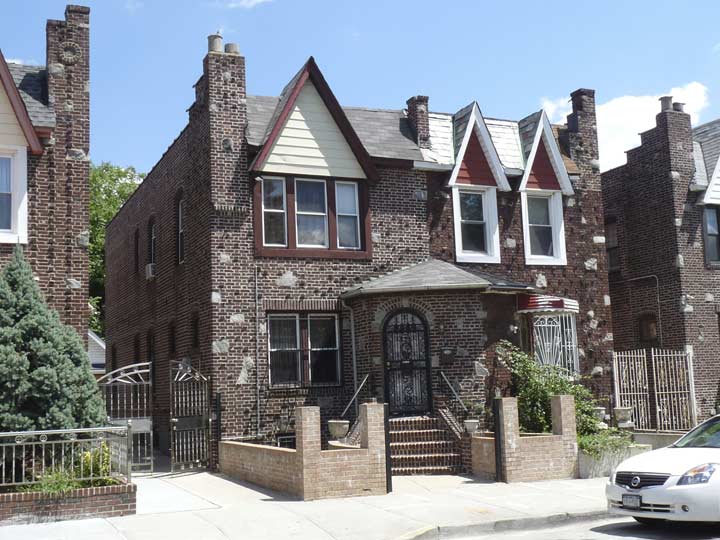
The northern end of Jackson Heights features several blocks of attached Tudor palaces, a style I have always admired, such as this group on 91st Street between Astoria Blvd. and 30th Avenue.

South of 30th Avenue on 91st: a series of alternating pitch-roofed and gambrel homes. Over time they have evolved into nonidenticality.
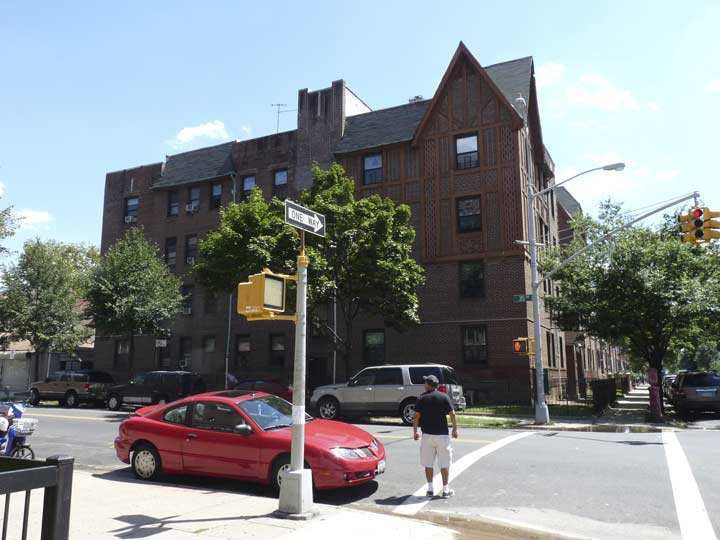
Further south in Jackson Heights the apartment buildings get more massive. Here’s another Tudor-flavored mid-20th Century building, at 35th Avenue and 90th Street.

At this point 7 miles had been walked and the balm of public transit was a relief…
11/15/15


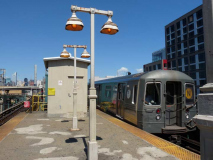

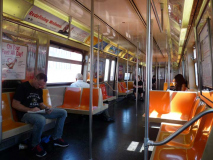





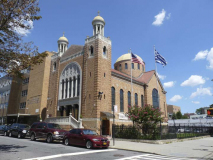






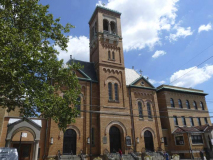






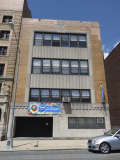















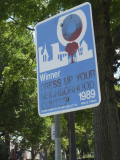












17 comments
Thank you for the great post on an area I’m very interested in.
The diesel locomotive you saw at Queensboro Plaza is only a couple years old, so nycsubway.org likely just hasn’t documented it yet. This model is the MP8AC-3 (the MTA classes it as R156):
https://en.wikipedia.org/wiki/MPI_MP8AC-3
These were built by MotivePower, Inc., in Idaho, if I remember correctly. Because they’re pretty lightweight compared to mainline rolling stock, these were shipped to NYC on flatcars and unloaded in Brooklyn. Here’s some video of the MTA taking delivery:
https://www.youtube.com/watch?v=Whm37ecPpc0
A 7 mile walk – impressive.
Great blog.
We lived in a converted two family home on 92nd street and Astoria BLVD in the early seventies. My mother would send me (five year old) every morning to the Fair Food Market on 91st and Astoria to pick up bread, the newspaper, and milk. Between the house and the Fair Food Market was an open sand dune lot that I would have to cross. The lot eventually became the Burger King on Astoria BLVD.
The photo of the Triboro theater was definitely not taken in 1943. Note that a trailer is parked in front; it has a car parked on it. The car is a 1949 or 1950 Mercury. So, the film “Sahara” may have been a 1943 release but the Mercury is post war.
I agree completely with NY2AZ, perhaps the date of the photograph is 1953 and there was a typo or misinformation on the labeling of the print when you sourced it for your book. GREAT photo by the way, as well as another great post. If one is an old motor car /gear head like NY2AZ and myself are, it is easier to date period photographs by the cars in the photo.
In the picture the sign on the trailer says that “Miss Steinway” will be chosen on Tuesday, October 19. October 19 fell on a Tuesday in 1948 and 1954. Given the rest of the background , 1948 seems the more likely date, and a new 1949 Mercury would be appropriate as a model care in late 1948.
Kevin: GREAT POST (as usual) !
As a child, I lived on 93rd Street between 31st and 32nd Avenues, so at one point you were a few blocks from the house I grew up in.
The small park with the approach lights was a favorite hangout when I was a teenager (long, long, long ago): at night, we would climb as high as possible on the tallest tower, and stand (if it had one) on the platform just below the lights. We would wait for an approaching airplane (prop driven in those days), and see who would be “chicken” and be the first to duck when the plane went over. Pure teenage stupidity, as the planes came in real low on foggy or rainy nights, and the prop wash could, and sometimes did, knock us off the platform to the ground below.
The FAIR was a great (and cheap) movie theater back in the late 50s and early 60s. Yes the movies were not “first run” events but at the price of admission you got to see TWO movies and a cartoon (usually Bugs Bunny, Road Runner or Pink Panther). Popcorn and soda were cheap and you could kill a whole rainy afternoon and still be home in time for dinner.
There were great diners on Astoria Blvd and 94th Street where I ate many a burger.
My childhood home was an attached stucco home with 3 bedrooms and only 1 bathroom. My dad give it a covering of aluminum siding not long after we moved in. It has a detached garage in the back (facing a “common” alley with the rears of the homes on 92nd Street). We had a small yard with flowers, that Mom attended to meticulously. Trash was not put out front but in the back alley, so that the garbage trucks could pick up two streets simultaneously.
I moved out in ’72 when I got married; Mom and Dad are gone now, and I sold the “old homestead” in 2007, but my heart will ALWAYS be in this neighborhood….
The diners were the Buccaneer and Deerhead, only the former survived
There was also the Wagon Wheel or was it called Red Wagon?
This is such a wonderful site! My Grand-father and his brothers owned a bar at the six corners (31st Avenue and Newtown Road). It was appropriately called “The Six Corners”. Have you ever heard anything about it? My Mom has old pictures that I’ll scan in and share at Christmas! Any info would be greatly appreciated!
“The only objection I have is that they apparently don’t carry Coke or Pepsi.”
A glass of water won’t kill you.
The third diner was the (Red?) Wagon Wheel.
The 3rd diner was the red wagon wheel, which is now the buccaneer.
Looking over the map of your route, I was a bit surprised to note that you didn’t mention Bulova Ave. or Bulova Park. The company was founded in 1875 in Manhattan by Joseph Bulova, and has a noteworthy legacy in the city. Perhaps that’s for a later post….
My Mom and Dad were married in St. Joseph’s RC church in June of 1941. My mother’s family lived nearby.
The MTA deserves credit for the wonderful job on the stair replacement at the Broadway station of the Astoria line. It is a careful upgrade of the original, using modern elements like the open-backed stair risers, and PVC pipe for rainwater control, while keeping honest to the original design. The even added a globe-and-bracket, which were not part of the original stair, but look perfect. Hopefully, they will continue this level of care with future repairs and restorations.
Really great going along with you on your “walk”.Thank you. Great photos and comments.